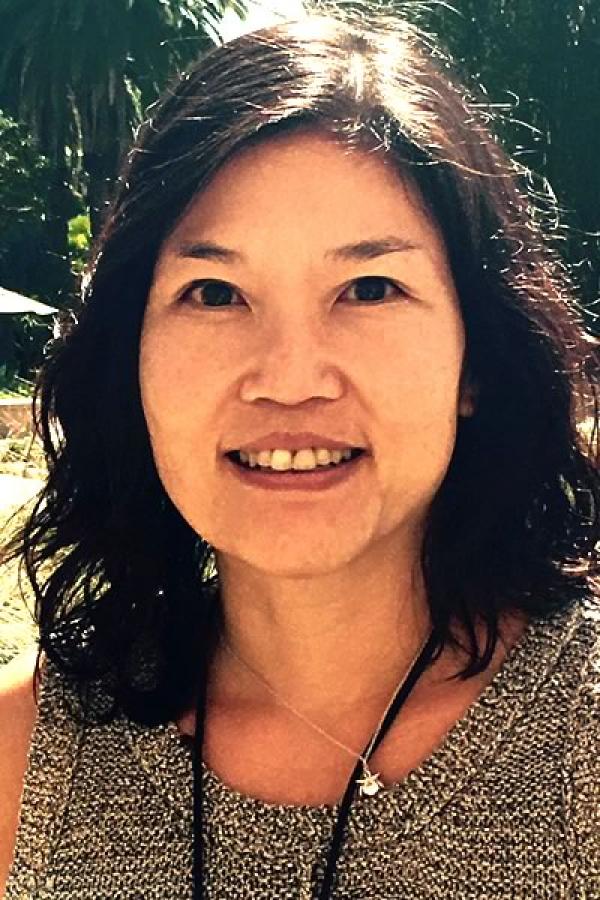Michelle H. Kim

Photo by Isabela Seong Leong Quintana
Bio
Michelle Har Kim is an instructor, writer, and editor based in the San Gabriel Valley, east of Los Angeles. Her recent USC dissertation, “Heterolingualism and the Asian Americas,” questions the apparent coherence of “Asian-American literature” as an ethnic genre, and considers how certain Spanish- and English-language texts grapple with unwieldiness of language in the plural Americas. This research first introduced her to the poetry of José Watanabe, and her life has never been the same. Michelle has taught most recently at California State University, Los Angeles; she has also worked as an ESL teacher, bookkeeper, copy editor, deposition summarizer, and night-shift legal word processor. Her first Watanabe manuscript is now complete, a Spanish-to-English translation of the poet’s only illustrated book of poetry, Historia natural (1996). Natural History is a collaboration with Watanabe’s dear friend, the Lima-based artist and illustrator Eduardo Tokeshi.
Translator's Statement
Not long before the poet’s Poesía completa was published in Madrid, somewhere in between inconsistent graduate school slogs, a wonderful thing happened. I was contacted out of the blue by a writer and translator who had some questions about an author I had been researching, José Watanabe. Our inquirer had found a couple poems I had translated in an academic paper. Virtually no one I had ever met in the United States, poetry people or not, knew much about Watanabe, so celebrated in his native Peru. My new friend lit a match, and I held it. We looked up at the shadow of an imminent English-reading audience.
I never wielded enough linguistic prowess, or “native” Spanish, to translate anything, that is, for anyone but myself. How would one even begin to translate the deceptive clarity and concision of Watanabe’s verse? I made it out to Lima one summer (or winter, depending on where you stand). It was a mere year after Watanabe had passed. I was miserable not to have met him. Not to be greeted with that fat, gruff, and deep voice that I know from recordings. I’d never be offered the straightest of answers from the maestro himself, responding to my many questions. Not that he would have allowed me any. But his absence propels me. It’s grown a sticky web around my foreignness, and encouraged its precariousness. I now cling to it. My advantage in inhabiting, at least for this moment, Watanabe’s final collection of poems entitled Banderas detrás de la niebla, or Flags Behind the Fog. The critic Naoki Sakai says that translation is decidedly not about replacing one language with another. Rather, it’s an act of “creating continuity out of discontinuity”; it is work by which we can incorporate and better respect—rather than overcome—language’s unpredictability and ambiguity.
"Cemetery" by José Watanabe
[Translated from the Spanish]
Due to municipal negligence
the peripheral walls that once harbored the dead
are now a heap of adobe.
They used to stand tall and tame the winds
that bewilder and swat around
the offerings we leave on these tombs’ wrangled earth.
Flowers scuttle from one body to another, or oranges
shriveled
or sandwiches decaying in banana leaves.
We relatives keep quiet
for death is finally reshuffling all amongst all.
Unyielding to detritus stands a robust column of clay.
It resists
and rises up
crowned in a magnificent sphere of plaster.
Its cracks and keen fissures
have drawn it hard and accidental features,
and the pillar is an angel of war ripped from its wings,
one embittered.
In late afternoons, when the fingers of light descend, biblical,
he, perverse, says no,
but the light penetrates the tombs to touch the foreheads of the dead
to tell them yes,
the promise, is yes.
About José Watanabe
Through moments familiar yet somehow illegible—an abrupt encounter with a mantis, or the echo of native ritual at a birthday, José Watanabe draws us closer to life’s illusory simplicity. A keen collaborator, appearing alongside his seven books of poetry anthologized in Poesía completa (2008) is Antígona (2000), rendered into verse for el Grupo Cultural Yuyachkani in honor of Peru’s desaparecidos, those who vanished amidst the colossal violence of the nation’s recent history. With Amelia Morimoto and photographer Óscar Chambi, Watanabe also wrote “the photographic history” La memoria del ojo: cien años de presencia japonesa en el Perú (The Memory of the Eye: One Hundred Years of Japanese Presence in Peru, 1999), which attests to the everyday life, confusion, and loss related to the WWII deportation of Japanese Peruvians northward to U.S. internment camps.

